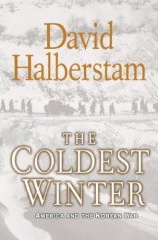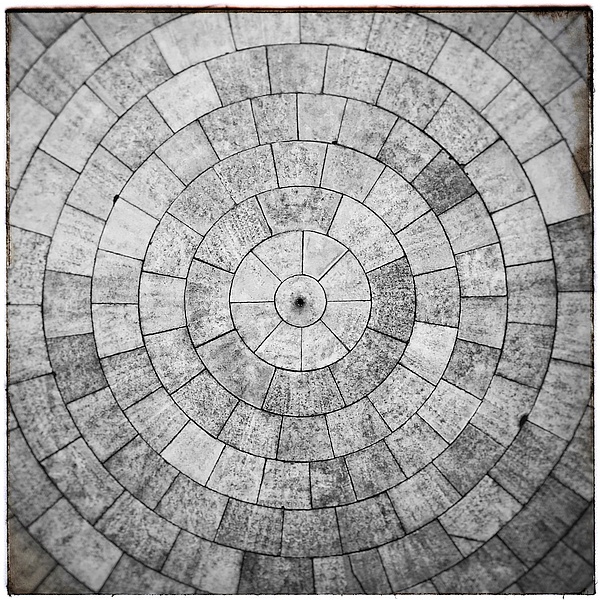 In days gone by, my commute via train served as a twice-daily opportunity for me to enjoy fairly long blocks of uninterrupted reading time. It’s been over four years since I left that routine, and since then I have welcomed the reduced commuting time as I missed my reading time and the people with whom I shared the commute. That is a roundabout way of saying that the reading I do now is grabbed in smaller chunks and occurs over much longer periods of time. Case in point – David Halberstam’s The Coldest Winter, which I just finished tonight having started it the week after Christmas. Some people might conclude that such a slow pace reflects not enjoying the book, and I assure you that was not the case.
In days gone by, my commute via train served as a twice-daily opportunity for me to enjoy fairly long blocks of uninterrupted reading time. It’s been over four years since I left that routine, and since then I have welcomed the reduced commuting time as I missed my reading time and the people with whom I shared the commute. That is a roundabout way of saying that the reading I do now is grabbed in smaller chunks and occurs over much longer periods of time. Case in point – David Halberstam’s The Coldest Winter, which I just finished tonight having started it the week after Christmas. Some people might conclude that such a slow pace reflects not enjoying the book, and I assure you that was not the case.
This book is Halberstam’s last book (a fact he presumably did not know during the ten years he worked on it), and it stands as a very eloquent monument to his skills as a storyteller and historian. Korea is famous for being the forgotten war. In an age when social studies have blotted out the foundational issues of any course of history – politics, diplomacy, and war – Korea presents too many ambiguities for many people to approach it. Did the U.S. win or lose? Who were we fighting? Were the Chinese put up to it by the Soviets? How could the victorious U.S. Army of 1945 have become the ragtag force facing its own Korean Dunkirk just five years later? How can an American military icon like Douglas MacArthur stumbled into disaster on such an epic scale when so many warnings were available to him? And on and on. America likes its wars clean and quick, and Korea was slow and dirty. No wonder it took so long for the Mall in Washington to gain a Korean Memorial.
What appeals to me most about this book is Halberstam’s careful efforts to place the war in multiple contexts – militarily of course, but also within the framework of Truman’s foreign policies and the nation’s domestic politics. The compromises that would mark the end of the war grow out of some domestic issues – notably the ‘loss’ of China – that remained a part of our politics long enough to influence our entry into Vietnam, linking this tale to Halberstam’s notable volume The Best and the Brightest. A good storyteller can take historical events and cover them across one dimension, such as economics, or art, or science. However, the mark of a careful hsitorian is the careful integration of multiple contexts to firmly fix his topic within its time and place. This triangulation across disciplines may not seem that hard, but it is so rarely done well that I think of it as a real mark of accomplishment. (Rhodes’s The Making of the Atomic Bomb and McPherson’s Battle Cry of Freedom are two elegant examples of historians writing fluidly across multiple disciplines).
By examining the war through a series of perspectives, including insight into the decisions and leaders behind China’s entry, the reader gains a fuller sense of the frustrations of the soldiers in the field and their immediate officers about the way in which our forces were committed, equipped, deployed, led, and often times squandered. The images of MacArthur and his staff court in Japan are shocking to contemplate. More devastating, we are shown how MacArthur’s faults are not aberrations of age, but rather lifelong habits. In particular, the 1942 acceptance by MacArthur and his senior staff of substantial cash ‘gifts’ from Philippine leader Manuel Quezon is something about which I have not read elsewhere, and is simply appalling. (It should come as no surprise that Eisenhower, when offered the same bribe, declined it and noted the incident in a memo to his Army personnel file.)
Halberstam’s penchant for interviewing sources gives the actual battle accounts of this book a vivid clarity. The sounds of Chinese bugles and trumpets will rng in your ears as the Chinese trap is sprung on the unprepared American troops as they marched towards the Yalu. The same attention to detail is devoted to the descriptions of men summoned to duty with no equipment or training suitable for the task ahead. Watching these men improvise in the face of deeply disheartening battlefield losses is one of the great success stories of American martial history, and it is told here in ways that are both noble and humane. There is no false glorification of the job these men undertook.
This book seeks to be a one-volume history, and so it condenses all sorts of details that can be found in other accounts. The author is upfront in his goals for the book, and I do not think that is a bad thing. If anything, this book will serve as a stepping stone into the literature of the Korean War. Books like Simmons’s Dog Company Six and Russ’s Breakout are obvious follow on volumes. Whether you are a reader who plans to stop at one volume or intends to embark on the whole Korea canon, I think you will find Halberstam’s book an insightful, rewarding work.
